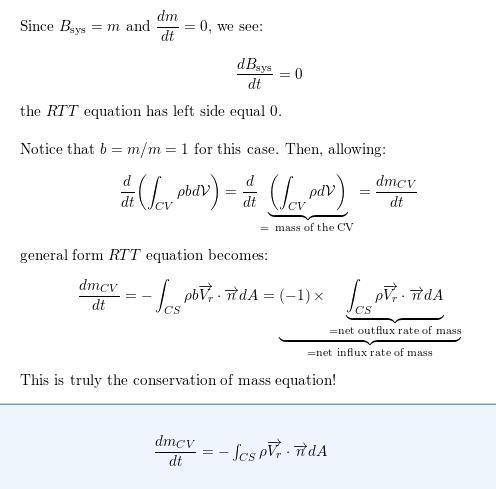
Engineering, 03.03.2020 02:59, sebascarvallo2003
Consider the general form of the Reynolds transport theorem (RTT) given by dBsys dt = d dt ∫CV rhob dV + ∫CS rhobV› r·n › dA where V › r is the velocity of the fluid relative to the control surface. Let Bsys be the mass m of a closed system of fluid particles. We know that for a system, dm/dt = 0 since no mass can enter or leave the system by definition. Use the given equation to derive the equation of conservation of mass for a control volume.

Answers: 3
Other questions on the subject: Engineering

Engineering, 03.07.2019 14:10, BardiFan
Amass of m 1.5 kg of steam is contained in a closed rigid container. initially the pressure and temperature of the steam are: p 1.5 mpa and t 240°c (superheated state), respectively. then the temperature drops to t2= 100°c as the result of heat transfer to the surroundings. determine: a) quality of the steam at the end of the process, b) heat transfer with the surroundings. for: p1.5 mpa and t 240°c: enthalpy of superheated vapour is 2900 kj/kg, specific volume of superheated vapour is 0. 1483 m/kg, while for t 100°c: enthalpy of saturated liquid water is 419kj/kg, specific volume of saturated liquid water is 0.001043m/kg, enthalpy of saturated vapour is 2676 kj/kg, specific volume of saturated vapour is 1.672 m/kg and pressure is 0.1 mpa.
Answers: 3

Engineering, 03.07.2019 15:10, breannaasmith1122
Two flowing streams of argon gas are adiabatically mixed to form a single flow/stream. one stream is 1.5 kg/s at 400 kpa and 200 c while the second stream is 2kg/s at 500 kpa and 100 ? . it is stated that the exit state of the mixed single flow of argon gas is 150 c and 300 kpa. assuming there is no work output or input during the mixing process, does this process violate either the first or the second law or both? explain and state all your assumptions.
Answers: 1

Engineering, 04.07.2019 18:10, wirchakethan23
Hydraulic fluid with a sg. of 0.78 is flowing through a 1.5 in. i. d. pipe at 58 gal/min. the fluid has an absolute viscosity of 11.8 x 105 lbf-sec/ft2. is the flow laminar, turbulent or within the critical range? give both a numerical reynolds number and a term answer.
Answers: 3

Engineering, 04.07.2019 18:10, samanthabutryn
Which one from below is not one of the reasons of planning failures? (clo3) a)-planner is careless. b-planner spend less time in the field but more time on the desk c)-planner is not qualified d)-planner does not have sufficient time to properly plan
Answers: 3
Do you know the correct answer?
Consider the general form of the Reynolds transport theorem (RTT) given by dBsys dt = d dt ∫CV rhob...
Questions in other subjects:



History, 10.03.2020 05:54













